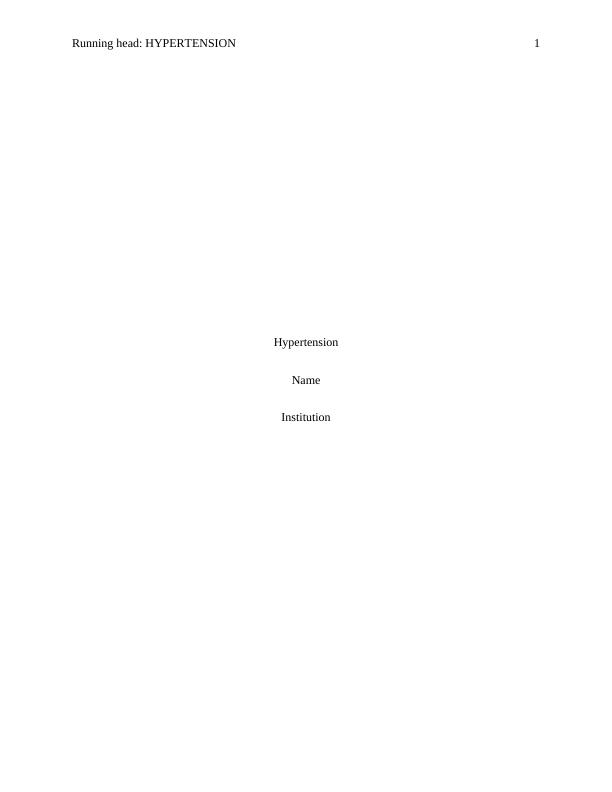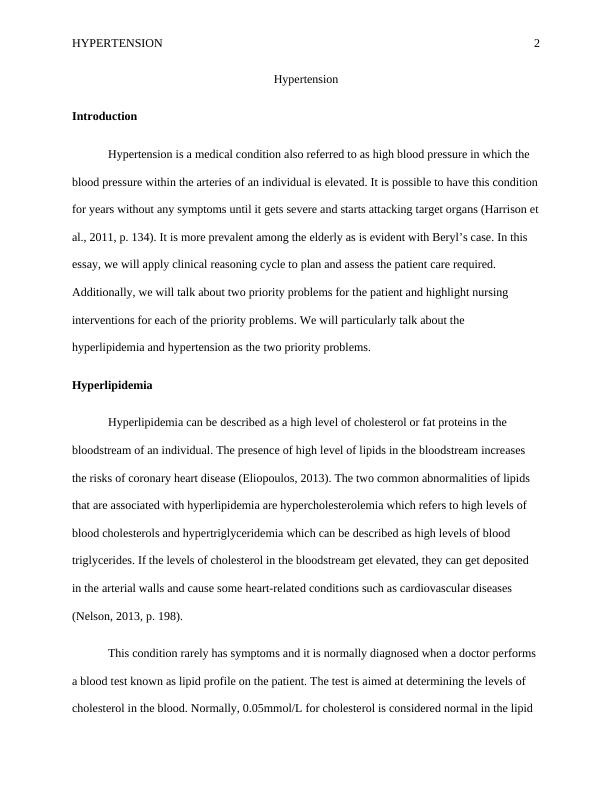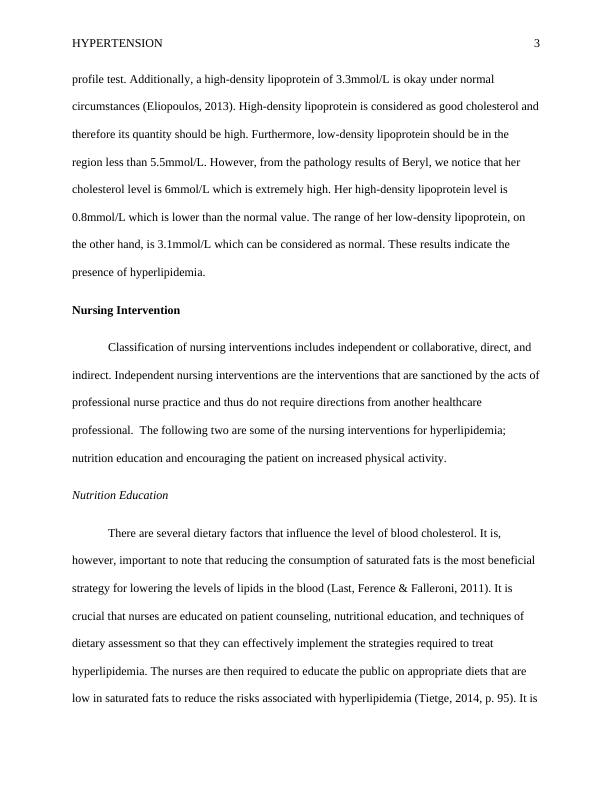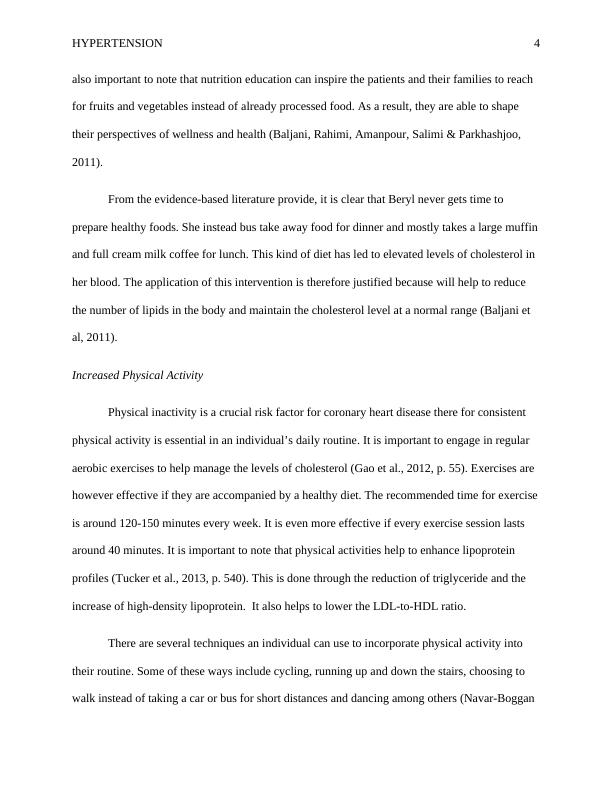Hypertension and Hyperlipidemia: Nursing Interventions
Added on 2023-06-14
11 Pages3276 Words163 Views
Running head: HYPERTENSION 1
Hypertension
Name
Institution
Hypertension
Name
Institution

HYPERTENSION 2
Hypertension
Introduction
Hypertension is a medical condition also referred to as high blood pressure in which the
blood pressure within the arteries of an individual is elevated. It is possible to have this condition
for years without any symptoms until it gets severe and starts attacking target organs (Harrison et
al., 2011, p. 134). It is more prevalent among the elderly as is evident with Beryl’s case. In this
essay, we will apply clinical reasoning cycle to plan and assess the patient care required.
Additionally, we will talk about two priority problems for the patient and highlight nursing
interventions for each of the priority problems. We will particularly talk about the
hyperlipidemia and hypertension as the two priority problems.
Hyperlipidemia
Hyperlipidemia can be described as a high level of cholesterol or fat proteins in the
bloodstream of an individual. The presence of high level of lipids in the bloodstream increases
the risks of coronary heart disease (Eliopoulos, 2013). The two common abnormalities of lipids
that are associated with hyperlipidemia are hypercholesterolemia which refers to high levels of
blood cholesterols and hypertriglyceridemia which can be described as high levels of blood
triglycerides. If the levels of cholesterol in the bloodstream get elevated, they can get deposited
in the arterial walls and cause some heart-related conditions such as cardiovascular diseases
(Nelson, 2013, p. 198).
This condition rarely has symptoms and it is normally diagnosed when a doctor performs
a blood test known as lipid profile on the patient. The test is aimed at determining the levels of
cholesterol in the blood. Normally, 0.05mmol/L for cholesterol is considered normal in the lipid
Hypertension
Introduction
Hypertension is a medical condition also referred to as high blood pressure in which the
blood pressure within the arteries of an individual is elevated. It is possible to have this condition
for years without any symptoms until it gets severe and starts attacking target organs (Harrison et
al., 2011, p. 134). It is more prevalent among the elderly as is evident with Beryl’s case. In this
essay, we will apply clinical reasoning cycle to plan and assess the patient care required.
Additionally, we will talk about two priority problems for the patient and highlight nursing
interventions for each of the priority problems. We will particularly talk about the
hyperlipidemia and hypertension as the two priority problems.
Hyperlipidemia
Hyperlipidemia can be described as a high level of cholesterol or fat proteins in the
bloodstream of an individual. The presence of high level of lipids in the bloodstream increases
the risks of coronary heart disease (Eliopoulos, 2013). The two common abnormalities of lipids
that are associated with hyperlipidemia are hypercholesterolemia which refers to high levels of
blood cholesterols and hypertriglyceridemia which can be described as high levels of blood
triglycerides. If the levels of cholesterol in the bloodstream get elevated, they can get deposited
in the arterial walls and cause some heart-related conditions such as cardiovascular diseases
(Nelson, 2013, p. 198).
This condition rarely has symptoms and it is normally diagnosed when a doctor performs
a blood test known as lipid profile on the patient. The test is aimed at determining the levels of
cholesterol in the blood. Normally, 0.05mmol/L for cholesterol is considered normal in the lipid

HYPERTENSION 3
profile test. Additionally, a high-density lipoprotein of 3.3mmol/L is okay under normal
circumstances (Eliopoulos, 2013). High-density lipoprotein is considered as good cholesterol and
therefore its quantity should be high. Furthermore, low-density lipoprotein should be in the
region less than 5.5mmol/L. However, from the pathology results of Beryl, we notice that her
cholesterol level is 6mmol/L which is extremely high. Her high-density lipoprotein level is
0.8mmol/L which is lower than the normal value. The range of her low-density lipoprotein, on
the other hand, is 3.1mmol/L which can be considered as normal. These results indicate the
presence of hyperlipidemia.
Nursing Intervention
Classification of nursing interventions includes independent or collaborative, direct, and
indirect. Independent nursing interventions are the interventions that are sanctioned by the acts of
professional nurse practice and thus do not require directions from another healthcare
professional. The following two are some of the nursing interventions for hyperlipidemia;
nutrition education and encouraging the patient on increased physical activity.
Nutrition Education
There are several dietary factors that influence the level of blood cholesterol. It is,
however, important to note that reducing the consumption of saturated fats is the most beneficial
strategy for lowering the levels of lipids in the blood (Last, Ference & Falleroni, 2011). It is
crucial that nurses are educated on patient counseling, nutritional education, and techniques of
dietary assessment so that they can effectively implement the strategies required to treat
hyperlipidemia. The nurses are then required to educate the public on appropriate diets that are
low in saturated fats to reduce the risks associated with hyperlipidemia (Tietge, 2014, p. 95). It is
profile test. Additionally, a high-density lipoprotein of 3.3mmol/L is okay under normal
circumstances (Eliopoulos, 2013). High-density lipoprotein is considered as good cholesterol and
therefore its quantity should be high. Furthermore, low-density lipoprotein should be in the
region less than 5.5mmol/L. However, from the pathology results of Beryl, we notice that her
cholesterol level is 6mmol/L which is extremely high. Her high-density lipoprotein level is
0.8mmol/L which is lower than the normal value. The range of her low-density lipoprotein, on
the other hand, is 3.1mmol/L which can be considered as normal. These results indicate the
presence of hyperlipidemia.
Nursing Intervention
Classification of nursing interventions includes independent or collaborative, direct, and
indirect. Independent nursing interventions are the interventions that are sanctioned by the acts of
professional nurse practice and thus do not require directions from another healthcare
professional. The following two are some of the nursing interventions for hyperlipidemia;
nutrition education and encouraging the patient on increased physical activity.
Nutrition Education
There are several dietary factors that influence the level of blood cholesterol. It is,
however, important to note that reducing the consumption of saturated fats is the most beneficial
strategy for lowering the levels of lipids in the blood (Last, Ference & Falleroni, 2011). It is
crucial that nurses are educated on patient counseling, nutritional education, and techniques of
dietary assessment so that they can effectively implement the strategies required to treat
hyperlipidemia. The nurses are then required to educate the public on appropriate diets that are
low in saturated fats to reduce the risks associated with hyperlipidemia (Tietge, 2014, p. 95). It is

HYPERTENSION 4
also important to note that nutrition education can inspire the patients and their families to reach
for fruits and vegetables instead of already processed food. As a result, they are able to shape
their perspectives of wellness and health (Baljani, Rahimi, Amanpour, Salimi & Parkhashjoo,
2011).
From the evidence-based literature provide, it is clear that Beryl never gets time to
prepare healthy foods. She instead bus take away food for dinner and mostly takes a large muffin
and full cream milk coffee for lunch. This kind of diet has led to elevated levels of cholesterol in
her blood. The application of this intervention is therefore justified because will help to reduce
the number of lipids in the body and maintain the cholesterol level at a normal range (Baljani et
al, 2011).
Increased Physical Activity
Physical inactivity is a crucial risk factor for coronary heart disease there for consistent
physical activity is essential in an individual’s daily routine. It is important to engage in regular
aerobic exercises to help manage the levels of cholesterol (Gao et al., 2012, p. 55). Exercises are
however effective if they are accompanied by a healthy diet. The recommended time for exercise
is around 120-150 minutes every week. It is even more effective if every exercise session lasts
around 40 minutes. It is important to note that physical activities help to enhance lipoprotein
profiles (Tucker et al., 2013, p. 540). This is done through the reduction of triglyceride and the
increase of high-density lipoprotein. It also helps to lower the LDL-to-HDL ratio.
There are several techniques an individual can use to incorporate physical activity into
their routine. Some of these ways include cycling, running up and down the stairs, choosing to
walk instead of taking a car or bus for short distances and dancing among others (Navar-Boggan
also important to note that nutrition education can inspire the patients and their families to reach
for fruits and vegetables instead of already processed food. As a result, they are able to shape
their perspectives of wellness and health (Baljani, Rahimi, Amanpour, Salimi & Parkhashjoo,
2011).
From the evidence-based literature provide, it is clear that Beryl never gets time to
prepare healthy foods. She instead bus take away food for dinner and mostly takes a large muffin
and full cream milk coffee for lunch. This kind of diet has led to elevated levels of cholesterol in
her blood. The application of this intervention is therefore justified because will help to reduce
the number of lipids in the body and maintain the cholesterol level at a normal range (Baljani et
al, 2011).
Increased Physical Activity
Physical inactivity is a crucial risk factor for coronary heart disease there for consistent
physical activity is essential in an individual’s daily routine. It is important to engage in regular
aerobic exercises to help manage the levels of cholesterol (Gao et al., 2012, p. 55). Exercises are
however effective if they are accompanied by a healthy diet. The recommended time for exercise
is around 120-150 minutes every week. It is even more effective if every exercise session lasts
around 40 minutes. It is important to note that physical activities help to enhance lipoprotein
profiles (Tucker et al., 2013, p. 540). This is done through the reduction of triglyceride and the
increase of high-density lipoprotein. It also helps to lower the LDL-to-HDL ratio.
There are several techniques an individual can use to incorporate physical activity into
their routine. Some of these ways include cycling, running up and down the stairs, choosing to
walk instead of taking a car or bus for short distances and dancing among others (Navar-Boggan

End of preview
Want to access all the pages? Upload your documents or become a member.
Related Documents
Hypertension and Hyperlipidemia: Case Studylg...
|12
|3624
|161
Integrated Nursing Practices Case Study: Nursing Interventions for Hypertension and Hyperlipidaemialg...
|12
|3229
|105
THE NURSING INTERVENTIONSlg...
|3
|584
|15
Hypercholesterolemia And Statins Assignmentlg...
|11
|2605
|17
Hyperlipidaemia: Causes, Symptoms, Risk Assessment, and Care Planlg...
|27
|1320
|238
Case Study with Beryl Assignmentlg...
|13
|3455
|153
